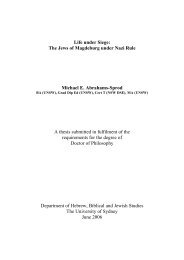Epimechus Dietz (Coleoptera: Curculionidae: Anthonomini)
Epimechus Dietz (Coleoptera: Curculionidae: Anthonomini)
Epimechus Dietz (Coleoptera: Curculionidae: Anthonomini)
You also want an ePaper? Increase the reach of your titles
YUMPU automatically turns print PDFs into web optimized ePapers that Google loves.
104<br />
imbricated, pallid scales laterally, with sparser,<br />
narrower scales medially; sternum 5 convex, with<br />
elongate, setiform scales medially. Legs: profemur<br />
with one small ventral tooth; protibia with inner<br />
margin prominent in basal 112, broadly concave<br />
apically, without pre apical tooth; protibial uncus<br />
stout; metatibia with inner margin strongly prominent<br />
in basal 112, strongly concave in apical 112,<br />
outer margin strongly curved in apical 112; metatibial<br />
mucro slightly curved in lateral view, with<br />
bulbous midlateral expansion in dorsal view, acute<br />
apically.<br />
Specimens examined. <strong>Epimechus</strong> aemulus IS<br />
known only from the holotype.<br />
Plant associations. Unknown.<br />
Remarks. <strong>Epimechus</strong> aemulus is known only from<br />
the female holotype. Fall (1901) described the species<br />
as "distinguishable at once from E. nevadicus,<br />
its nearest ally, by its larger size and seven-jointed<br />
funicle." The closest relatives of E. aemulus appear<br />
to be E. flavirostris and E. curvipes. However,<br />
without males of E. aemulus, this remains uncertain.<br />
The species is more similar in size and form to<br />
E. flavirostris (cf. Figs. 3-6) and has a similar acute<br />
ventral tooth on the profemur. It also resembles E.<br />
flavirostris in the dense vestiture of broad scales,<br />
but unlike that species it has a broad median vitta<br />
of pallid cretaceous scales on the pronotum, the<br />
elytra with a dense humeral patch, inters tria 4 for<br />
most of its length and inters tria 6 basally with<br />
similar broad, pallid scales. The rostrum of E.<br />
aemulus is more like that of E. curvipes. The<br />
rostrum of E. flavirostris is sparsely punctate basally<br />
and smooth, shining and glabrous throughout,<br />
except at the extreme base, the integument<br />
pallid, E. aemulus and E. curvipes have the rostrum<br />
rugose-punctate basally, punctulate distally,<br />
with sparse, narrow scales basally, the integument<br />
dark.<br />
<strong>Epimechus</strong> flavirostris Fall<br />
Figs. 5, 6, 24, 36, 37<br />
<strong>Epimechus</strong> flavirostris Fall 1928:239-240. Holotype.<br />
United States. California. Los Angeles Co.: [Fairmont/<br />
L. A. Co.! CAL.! IV-15-28] [A. C.! Davis]<br />
[male] [TYPE/ flavirostris] [M.C.Z.! Type/ 25183]<br />
[H. C. FALL! COLLECTION] (male, MCZC).<br />
Volume 15, No.2, June, 2001, INSECTA MUNDI<br />
Male (Figs. 5, 6). Length.: 1.8-2.8mm. Width: 0.8-<br />
1.2mm. Head: foveate, with dense, broadly imbricated,<br />
apically rounded, pallid scales. Rostrum:<br />
evenly curved; proximal portion with dense, imbricated<br />
scales at extreme base, otherwise smooth,<br />
shining, glabrous; distal portion glabrous. Antenna:<br />
funiculus with 7 segments. Pro thorax: pronotum<br />
with dense, imbricated, apically rounded, scales;<br />
broader cretaceous to leucine scales predominant<br />
medially and laterally on dorsum, replaced on dorsolateral<br />
portions by fuscous or admixed fuscous<br />
and lighter fulvous scales; fulvous and fuscous<br />
scales also intermixed on pleuron. Elytra: narrow,<br />
subparallel-sided, rounded apically; striae mostly<br />
concealed by scales, punctures with minute, inconspicuous<br />
setae; interstriae with dense, apically<br />
rounded, imbricated, multiseriate, recumbent<br />
scales; each interstria also with diffuse median row<br />
of narrower scales; pallid cretaceous to leucine<br />
scales dense basally on sutural interstriae and<br />
interstria 6 and on longer median and posteromedian<br />
portions of interstria 4, variously interspersed<br />
elsewhere among admixed fuscous and fulvous<br />
scales; sutural interstriae not prominent. Pygidium:<br />
evenly convex. Abdomen: sterna 1-4 with dense,<br />
imbricated, pallid scales; sternum 5 convex, with<br />
elongate, setiform scales medially. Legs (Fig. 24):<br />
femora stout; profemur minutely toothed; protibia<br />
with inner marginal prominent in basal 112, concave<br />
in apical 112; protibial uncus slender, curved;<br />
metatibia of male with inner margin prominent in<br />
basal 1/3, strongly concave in apical 2/3, outer<br />
margin strongly curved in apical 1/2; metatibial<br />
mucro stout, slightly curved in lateral view, broadly<br />
excavated; metatibia of female with inner margin<br />
slightly prominent in basal 2/3, slightly concave<br />
in apical 113, outer margin straight; metatibial<br />
mucro slender, acute, oblique; tarsal claw without<br />
basal tooth. Genitalia (Fig. 36, 37): median lobe of<br />
aedeagus strongly narrowed in apical 114, slightly<br />
expanded at extreme apex; endophallus minutely<br />
denticulate, with one slender, acute sclerite.<br />
Specimens examined. In addition to the holotype<br />
from Fairmont, California, 52 specimens of E. flavirostris<br />
from the following localities were examined.<br />
United States. Arizona. Coconino Co.: Williams<br />
(1, OSUC). Mohave Co.: Hualpai Mountains<br />
(1, OSUC); 18 mi. NW Kingman (1, TAMU). Pima<br />
Co.: Tucson (1, OSUC). California. Inyo Co.: Anvil<br />
Springs, Butte Valley, Panamint Range (4,200', 1,<br />
CDAE); 31 mi. NE Big Pine (2, CWOB); Deep<br />
Springs (1, CISC); Independence (1, CASC); 10-20
















